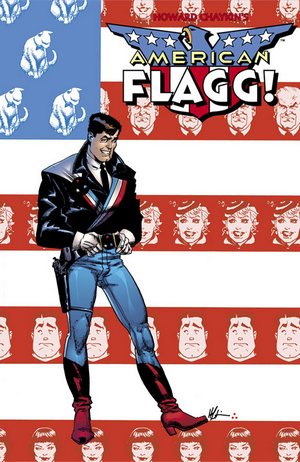- Comics
- Comics Reviews
- Manga
- Comics Reviews
- European Comics
- News
- Comics News
- Press Releases
- Columns
- Spotlight
- Digital Comics
- Webcomics
- Cult Favorite
- Back Issues
- Webcomics
- Movies
- Toys
- Store
- More
- About
By Leroy Douresseaux
November 4, 2008 - 10:22
 |
| Cover image for American Flagg! Definitive Collection Volume 1 (although the AF logo on the upper right corner of this image is not actually on cover). |
After being out of print practically since its original publisher closed in 1991, American Flagg!, the 1980’s dystopian science fiction comic book series by Howard Chaykin, is finally back in print. American Flagg!: Definitive Collection Volume 1 reprints the material found in American Flagg! #1-14 and the graphic novel American Flagg: Hard Times (a 1985 “First Comics Graphic Novel,” which reprinted American Flagg! #1-3 with new coloring).
Created, written, drawn, and designed by Howard Chaykin, American Flagg! was published by now-defunct publisher, First Comics, and ran for 50 issues from 1983-88. The series was set in the year 2031, but the state of the world in the 2030s was set in 1996, the Year of the Domino. It was then that a series of worldwide crises forced the U.S. government and the heads of major corporations to relocate to Mars.
The exiled American government on Mars, its corporate backers, and a group of technicians on a defected Soviet lunar colony formed the Plex: an interplanetary union that governed the United States from its capital on Mars. The Plex created massive, fortified populations centers that basically transformed cities and urban areas into giant shopping malls called Plexmalls. In the Plexmalls the law is enforced not by police departments, but by the Plexus Rangers. The series follows the adventures of Reuben Flagg, a former television star who is drafted into the Rangers and is transferred to Chicago’s Plexmall. It is in his new job that Flagg’s eyes open to the true nature of the Plex.
American Flagg!: Definitive Collection Volume 1 includes an introduction by Michael Chabon (The Amazing Adventures of Kavalier and Clay) and an afterword by beloved comic book artist, Jim Lee (Uncanny X-Men, All Star Batman and Robin, the Boy Wonder). Chabon’s introduction isn’t so much an introduction as it is a piece for a scholarly journal or high brow literary magazine, so it tends to ramble. On the other hand, Jim Lee’s afterword at the end of the book is short and to the point. Actually, Lee summarizes what made American Flagg! memorable better than Chabon does (and with far fewer words) because Lee is an artist and Chabon is a writer, and Flagg! was about the art.
Comic books are a graphic storytelling medium. While this may be obvious to most readers, the reality of what’s on the pages of typical comic books suggests otherwise. Far too many comic books are stories in which the script, in the form of word balloons and captions, is entirely divorced from the other thing on the page, the visuals – the comic book art. That’s because so many comic book artists – even tremendously talented ones – are treated like art robots that are merely providing illustrations for text. The eyes follow the words, and the art is secondary – a visually pleasing second banana, but still secondary.
In American Flagg!, creator Howard Chaykin, as writer/artist, with letter Ken Bruzenak and colorist Leslie Zahler, created a seamless whole. Instead of the story, art, lettering, and color seeming like separate elements, in American Flagg!, they combined to create each page as an eye-catching graphic total that told moments in a larger graphic narrative. Jim Lee is correct. At the time, nothing else in North American comics looked like American Flagg! One can give Chaykin credit for the ideas (some of which seem prophetic today), plots, and concepts, as well as the snappy, cynical, and imaginative dialogue (as Chabon does), but what truly makes American Flagg! memorable today and a landmark then was the graphic presentation.
Chaykin was more than just a writer/artist; he was also a designer, and it was his innovative graphic design that caught the notice of the young Jim Lee, a comic book reader before he was a superstar comic book creator. So fresh and ground-breaking was American Flagg! that it also likely influenced two comic books that would appear just a few years after Flagg! debuted, The Dark Knight Returns and Watchmen, two series that are seen as the most influential comics of the last two decades. [The legacy of American Flagg! would appear again in the 1990s in Warren Ellis’ Transmetropolitan.] Perhaps, neither would be so significant without the story and visual ideas American Flagg! presented to their respective creators.
What American Flagg!: Definitive Collection Volume 1 does is bring this landmark work back into print where it belongs, so that new readers can see that Flagg! wasn’t just a landmark work, it was also a damn fine reading experience. The truth of the matter is that a quarter century later, Howard Chaykin’s comic book still looks pioneering compared to the mediocrity that defines the comic books of the North American Direct Market. This collection also includes a new Reuben Flagg story (“I Want My Empty V”) written and drawn by Chaykin, with colors from Brian Haberlin, and this new story shows that Howard and Reuben still have the magic.